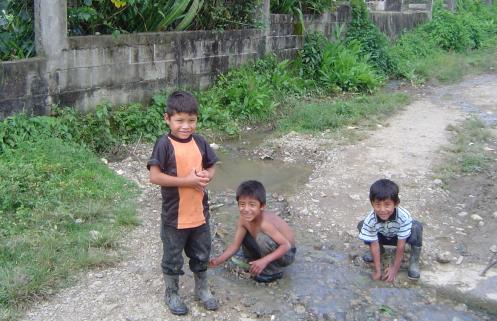
 Think “energy poverty” and the first image that comes to mind is likely a remote village with no electricity. But it’s quite possible to be connected to the grid—even to live in a large city—and still be in a state of energy poverty. In a recent interview for the ECPA newsletter, a researcher in Mexico talked about some of the challenges countries in the region face as they seek to reduce inequality and provide access to “affordable, reliable, sustainable and modern energy for all,” as Sustainable Development Goal 7 puts it.
Think “energy poverty” and the first image that comes to mind is likely a remote village with no electricity. But it’s quite possible to be connected to the grid—even to live in a large city—and still be in a state of energy poverty. In a recent interview for the ECPA newsletter, a researcher in Mexico talked about some of the challenges countries in the region face as they seek to reduce inequality and provide access to “affordable, reliable, sustainable and modern energy for all,” as Sustainable Development Goal 7 puts it.For Rigoberto García Ochoa—a professor and researcher at the Colegio de la Frontera Norte (College of the Northern Border) in Nogales, Mexico—energy poverty simply describes people’s inability to satisfy their basic energy-related needs. Access to electricity is part of it, but far from the only factor.
“There are many families who have access to electricity, but do not have the minimum equipment needed to have a minimally adequate quality of life,” said García Ochoa, a PhD in urban and environmental studies who has studied energy poverty extensively in Mexico.
One key factor in defining the energy poverty threshold, he said, is whether people are forced to rely on firewood for cooking. Some 5 million people in Mexico cook only with firewood, according to García Ochoa, making it the second fuel source after liquified natural gas—more common, even, than electricity. Even many city dwellers still use firewood or charcoal as fuel for cooking, the researcher added. (According to the World Health Organization, every year more than 4 million people around the world die prematurely from illnesses attributable to indoor air pollution from cooking with solid fuels.)
Another factor that figures into energy poverty is indoor comfort. In northern Mexico, the issue is availability of cooling rather than heating, so in determining whether a family is energy-poor, García Ochoa looks at whether the home has an air conditioner, electric fans, or some other cooling system. Access to hot water, adequate lighting, and refrigerators and other appliances also go into the equation.
 In 2014, based on such factors, García Ochoa calculated that around one third of households in Mexico were in some state of energy poverty, with different degrees of severity. By contrast, only about 1 percent of the population lacked access to electricity—though this is still a significant number of people, around 1.2 million. García Ochoa is in the process of updating those figures with data through 2016.
In 2014, based on such factors, García Ochoa calculated that around one third of households in Mexico were in some state of energy poverty, with different degrees of severity. By contrast, only about 1 percent of the population lacked access to electricity—though this is still a significant number of people, around 1.2 million. García Ochoa is in the process of updating those figures with data through 2016.
Energy poverty—or fuel poverty, as it is sometimes called—is just one aspect of the broader, multidimensional problem of poverty in general. It has been a prominent and thoroughly studied issue in many European countries since the 1970s, when the first oil crisis put the cost of home heating fuel out of reach for many people.
García Ochoa has seen interest in the subject grow recently in Latin America and the Caribbean—something he largely attributes to the focus on the Sustainable Development Goals. Chile has made the most progress on this issue in the region, he said, noting that the Ministry of Energy has been working with the United Nations Development Programme (UNDP) to study the problem of energy poverty and come up with definitions to help guide policy.
A conference on energy poverty will be held April 12-13 at the Colegio de la Frontera Norte in Ciudad Juárez, Mexico; the Universidad Autónoma de Ciudad Juárez and Universidad Autónoma de Chihuahua are co-sponsors. The event will include several dozen speakers, including academics from Chile and the United States. One goal, García Ochoa said, is to form a regional network on energy poverty.
Here are some of the key points about energy poverty that García Ochoa made during the recent interview:
Governments should consider the social dimension of energy use. “I think we have focused a lot on the economic aspect and on the environmental aspect, but the social dimension has been left behind,” García Ochoa said.
When sustainable energy is framed simply in terms of environmental benefits, it can seem like just another economic burden for developing countries—especially since they do not bear most of the responsibility for climate change, García Ochoa said. But if sustainable energy were viewed more as a tool to advance human development, he said, countries would be more willing to make the necessary investment to benefit the population.
It’s possible to reduce energy inequality and still be environmentally responsible. “I’m convinced that overcoming energy poverty does not have to affect the environment,” García Ochoa said. By focusing on renewable sources such as solar energy and emphasizing energy efficiency, he said, countries in the region can tackle the problem of energy poverty without significantly increasing their output of greenhouse gases.
Currently, according to García Ochoa, the average person in the United States consumes about five times as much energy as his or her counterpart in Mexico, while the average European consumes two to three times as much as the average Mexican. The idea isn’t for developing countries to match developed countries’ consumption per capita, but to reduce inequality and provide everyone with the opportunities that come with clean, affordable energy.
Energy poverty cannot be measured the same in every country. In southern Chile, where the winters are cold, the lack of indoor heating would be a much more important indicator of energy poverty than in a place with a more moderate climate. Social and cultural factors also come into play, García Ochoa said; for example, in some places people may cook with firewood by choice or custom, not because they cannot afford a stove.
The better the raw data, the more accurate the picture of energy poverty will be. Researchers in this field often lack enough information to define problems as sharply as they would like. In some developed countries, governments conduct highly detailed household surveys that show not only whether a family has a refrigerator, for example, but how new it is, and therefore how efficient. That helps policymakers come up with better solutions to tackle specific problems. “We have to work with the data we have,” García Ochoa said.
It’s important to have not only better data, but better policy coordination. In other words, García Ochoa said, a government agency that promotes renewable energy should be working hand in hand with agencies that focus on housing or on poverty reduction, for example. Such coordination would lead to more creative solutions, save resources, and be more effective in advancing human development.
Cover photo: Powermundo
 View Map
View Map